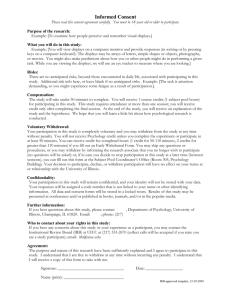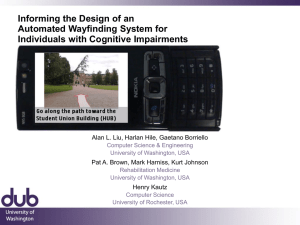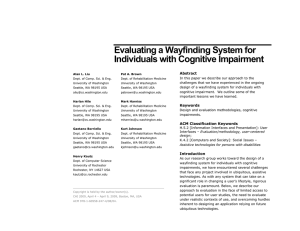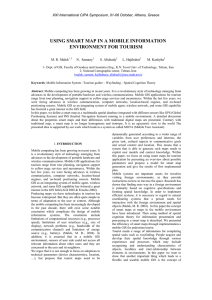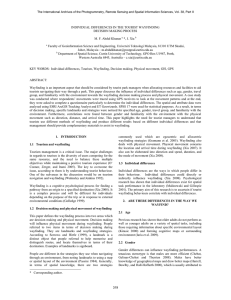Human Factors Psychology
advertisement
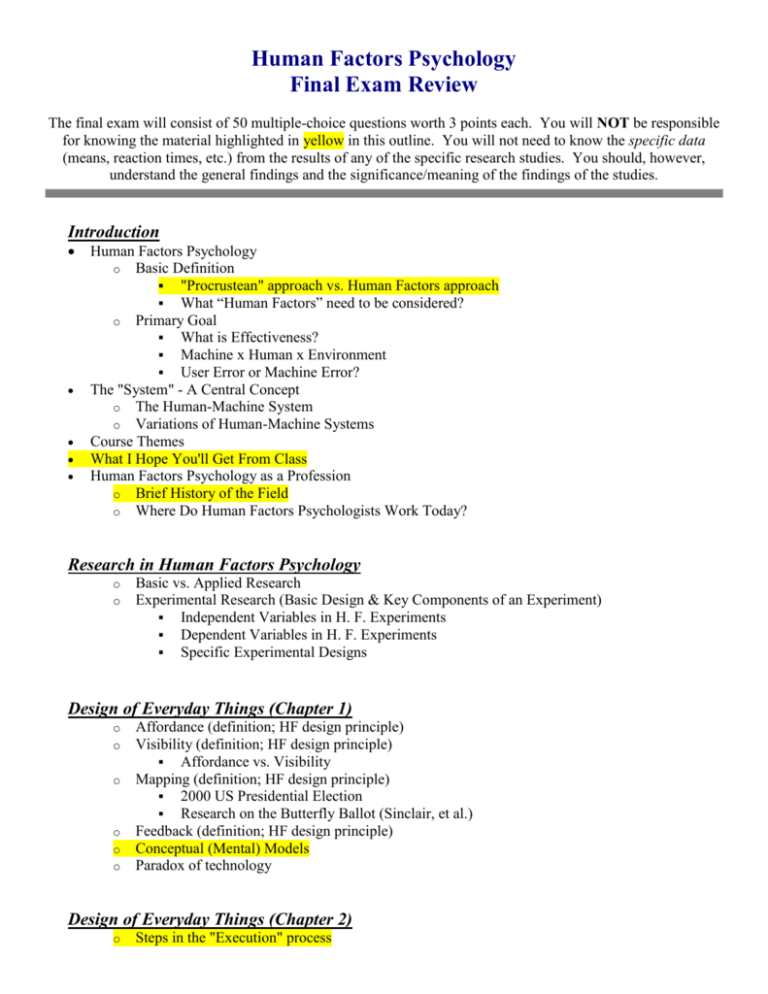
Human Factors Psychology Final Exam Review The final exam will consist of 50 multiple-choice questions worth 3 points each. You will NOT be responsible for knowing the material highlighted in yellow in this outline. You will not need to know the specific data (means, reaction times, etc.) from the results of any of the specific research studies. You should, however, understand the general findings and the significance/meaning of the findings of the studies. Introduction Human Factors Psychology o Basic Definition "Procrustean" approach vs. Human Factors approach What “Human Factors” need to be considered? o Primary Goal What is Effectiveness? Machine x Human x Environment User Error or Machine Error? The "System" - A Central Concept o The Human-Machine System o Variations of Human-Machine Systems Course Themes What I Hope You'll Get From Class Human Factors Psychology as a Profession o Brief History of the Field o Where Do Human Factors Psychologists Work Today? Research in Human Factors Psychology o o Basic vs. Applied Research Experimental Research (Basic Design & Key Components of an Experiment) Independent Variables in H. F. Experiments Dependent Variables in H. F. Experiments Specific Experimental Designs Design of Everyday Things (Chapter 1) o o o o o o Affordance (definition; HF design principle) Visibility (definition; HF design principle) Affordance vs. Visibility Mapping (definition; HF design principle) 2000 US Presidential Election Research on the Butterfly Ballot (Sinclair, et al.) Feedback (definition; HF design principle) Conceptual (Mental) Models Paradox of technology Design of Everyday Things (Chapter 2) o Steps in the "Execution" process o o o Steps in the "Evaluation" process Gulf of Execution and Gulf of Evaluation Two “Gulfs” are Independent Attributions for Errors Learned Helplessness/Taught Helplessness Basic Design Issues o o o o Definition of Design Design Involves Tradeoffs Some Considerations in Design Data on Traffic Deaths Guiding Human Factors Principles of Design A Model of the Basic Design Process (5-stage model) Requirements Analysis Conceptual Design Mockups & Prototypes Production Launch Know details of each stage Whistleblowing o o o o Definition Why do people blow the whistle? Specific Forms of Whistleblowing The Space Shuttle Challenger Story Human Memory & Human Factors o o o Stage Theory of Memory Specifics on STM & LTM (Types of Information in LTM) Some Things We Forget When Using Technology Why Do We Forget? "The Design of Everyday Things" (Chapter 3) o o o o o o "Knowledge" Knowledge in the Head Knowledge in the World Constraint Continuum of “Knowledge” Tradeoffs Between Knowledge in Head and World Anthropometry & Biomechanics o o Basic Definitions Sources of Anthropometric and Biomechanical Variability Anthropometry (Static & Dynamic Dimensions) Static Dimensions Normal Distribution How are Static Dimensions Measured? Static Dimensions of Pregnant Women (Culver & Viano research) o o Dynamic Dimensions Biomechanics Applying Anthropometric & Biomechanical Data in Design Design for Extreme User Design for maximum Design for minimum Design for Adjustable Range Displays Definition Nature of Information From “Systems” o Dynamic (Qualitative & Quantitative) o Static (Examples) Coding Visual Displays o Definition o Common “Coding Dimensions” for Visual Displays o Visual Display of Dynamic Quantitative Information Digital vs. Analog Displays (Miller & Penningroth research methodology & results) Digital or Analog Display? (Potential Problems with Analog Displays) Displaying Research Data o o Types of Data Display Formats Displaying Data (Meyer, Shinar, & Leiser research methodology & results) Signs as Diplays o o o Information Conveyed Through Signs Factors Influencing Effectiveness of Signs Sign Location (Foster research methodology & results) Wayfinding o o o Definition / Where an Issue Characteristics of Environment that Influence Wayfinding Wayfinding Easiest if . . . Directional Aides and Wayfinding (Butler research methodology & results) Errors & Accidents o o Errors & Accidents (Norman: Mistake vs. Slip) Reducing Human Error and Accidents Design of Technology Assists Location of Warnings on Products (Frantz & Rhoades research methodology & results) Automotive Human Factors o o o o Overview Using Perceptual Illusions to Slow Drivers (Denton research methodology & results) Estimating Distances in Fog (Cavallo, Colomb, & Dore research methodology & results) How Effective is the Third Brake Light? (McKnight & Shinar research methodology & results)
